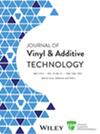Effect of solid lubricant additives on solid particle erosion characteristics of rigid and toughened epoxy resins
Abstract
Solid lubricants are added to polymers to upgrade their tribological properties, especially in cases where adhesive and abrasive friction are valid. However, there are not enough studies on the effects of solid lubricants on particle erosion. This study investigated the effects on solid particle erosion behavior of three different well known solid lubricants (molybdenum disulfide, polytetrafluoroethylene, and graphite). These solid lubricants were added at three different ratios (5, 10, and 15 wt.%) to the two different type (rigid and toughened) epoxy resins. Garnet abrasive particles (180–400 μm) were blasted to the sample surface under 1.5 bar for 15 s to conduct solid particle erosion tests. The erosive wear mechanisms of neat and solid lubricant-reinforced epoxy resins were investigated in relation to the epoxy type, solid lubricant type, and solid lubricant reinforcement ratio. Statistical analysis was performed according to response surface methodology to support the experimental results, and ANOVA tables were obtained. The wear and deformations that occurred on the surface after solid particle erosion were examined using a noncontact optical profilometer system and scanning electron microscopy, and a significant relationship was detected between the deformation on the surface and particle erosion. Analysis results showed that the factor causing the greatest erosion rate change was the epoxy resin type. Finally, it has been observed that all solid lubricants reduce the erosive wear resistance, and this resistance decreases as the weight ratio increases.
Highlights
- Investigations were conducted into the erosion behavior of two types of epoxy resins: rigid and toughened. The toughened epoxy resin exhibited greater resistance to erosion. Although it has the same type of content, on average, rigid epoxy worn 2–4 times more than toughened epoxy.
- The effect of adding polytetrafluoroethylene tended to increase the erosion rate of both rigid and toughened epoxy resin less than that of other solid lubricants.
- Graphite particles increased the erosion rate of toughened epoxy by 1.5–3 times and that of rigid epoxy by 2–3 times, depending on the value of the reinforcement ratio.
- MoS2 increased the erosion rate of toughened epoxy by 1.5–3 times and that of rigid epoxy by 2–3 times.
- Using a noncontact optical profilometer (for investigating surface topography), it was proven that there is a significant relationship between the erosion rate and roughness characteristics. Wear mechanisms were identified by SEM analysis.


 求助内容:
求助内容: 应助结果提醒方式:
应助结果提醒方式:


